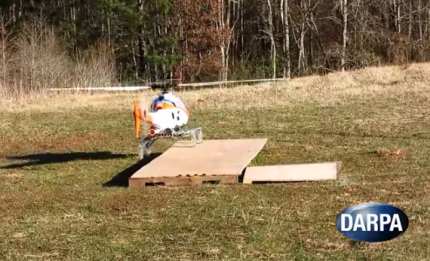DARPA gives helicopters robotic legs for landing in rough spots
The agency and Georgia Tech researchers would improve the ability to land on rugged terrain or storm-tossed ships.
A screen grab from DARPA’s video shows a demonstration helicopter making an uneven landing.
Military researchers are looking to give helicopters the same kind of agility when landing as they have in the air by giving them flexible, adaptive robotic legs that would let them land on uneven, difficult or moving surfaces.
Despite their airborne maneuverability, helicopters, with their skid-and-wheel landing gear, still need a level surface to set down. Landing on an uneven surface could cause the aircraft to tip over or the rotor blades to come into contract with the ground. And there are plenty of uneven surfaces on battlefields, ships and disaster areas.
Researchers with the Defense Advanced Research Projects Agency and the Georgia Institute of Technology are looking to give helicopters the ability to handle rugged terrain or moving surfaces (such as ship being tossed in roiling waters) through DARPA’s Mission Adaptive Rotor (MAR) program.
The gear developed under the program was demonstrated recently near Atlanta.
The system gives a helicopter four jointed legs, each with force-sensitive contact sensors in their feet, DARPA said in an announcement. Each leg would extend and then react individually to the surface it comes in contact with, so that each leg could be flexed in a different position when it lands—depending on the surface—keeping the helicopter itself level.
“The equipment—mounted on an otherwise unmodified, unmanned helicopter—successfully demonstrated the ability to land and take off from terrain that would be impossible to operate from with standard landing gear,” said Ashish Bagai, DARPA program manager, who discussed the demonstration at Wait, What? A Future Technology Forum taking place in St. Louis.
Bagai said there are significant advantages to using the robotic landing gear, including that it would reduce the risk of damage from hard landing by a factor of five.
The gear also will allow for stable take-offs and landing on slopes of up to 20 degrees—more than twice what’s possible with conventional landing gear—as well as on storm-tossed ships. All these advantages come with only a small increase in the landing gear weight, Bagai said.
DARPA said Georgia Tech researchers are continuing to develop the gear.
NEXT STORY: Inmarsat gets $450M satellite contract
